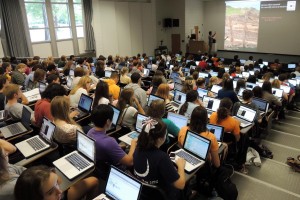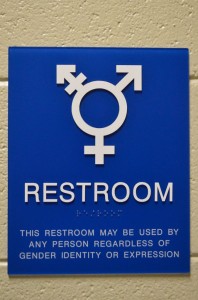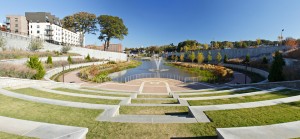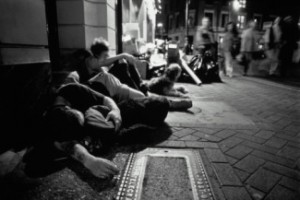Category Archives: Annotated Bibliography
Annotated Bibliography 9
Annotated Bibliography 8
Bram, Thursday. “Just Scroll With It.” Entrepreneur 41.12 (2013): 22. Business Source Complete. Web. 25 Mar. 2016.
 In Thursday Bram’s article,”Just Scroll With It”, she discusses the effective use of Parallax Design on a website can significantly impact the way visitors of a website interact and learn with the content shown. Parallax design uses scrolling to show new images or highlight specific information by moving various sections of a site at different speeds. Images, typography and other page elements can appear differently, based on what point in the page a visitor has reached. Parallax Designs give opportunities for websites to closely control which sections remains in front of a visitor’s eyes the longest and the use of motion to draw attention to the most important components. Parallax Design is tool that employs clear information architecture, guiding visitors attention to what a website wants to inform.Parallax design is a relatively new trend in web design; it is not yet possible to quantify its impact on traffic and user engagement. But anecdotal evidence suggests that the unique visuals lead users to spend more time on sites and even to share them as examples of great design.
In Thursday Bram’s article,”Just Scroll With It”, she discusses the effective use of Parallax Design on a website can significantly impact the way visitors of a website interact and learn with the content shown. Parallax design uses scrolling to show new images or highlight specific information by moving various sections of a site at different speeds. Images, typography and other page elements can appear differently, based on what point in the page a visitor has reached. Parallax Designs give opportunities for websites to closely control which sections remains in front of a visitor’s eyes the longest and the use of motion to draw attention to the most important components. Parallax Design is tool that employs clear information architecture, guiding visitors attention to what a website wants to inform.Parallax design is a relatively new trend in web design; it is not yet possible to quantify its impact on traffic and user engagement. But anecdotal evidence suggests that the unique visuals lead users to spend more time on sites and even to share them as examples of great design.
I chose this source because it relates to what our class is doing now, where each student is designing there own blog in there own personal way and attempting to put it in a form that allows visitors to effectively learn about the built environment.
Annotated Bibliography 7
Keung, Hon and Alison Lai Fong Cheng, Wing Man. “Identify The Motivational Factors To Affect The Higher Education Students To Learn Using Technology.” Turkish Online Journal Of Educational Technology 14.2 (2015): 89-100.Education Source. Web. 25 Mar. 2016.
In Hon Keung article,”Identify The Motivational Factors To Affect The Higher Education Students To Learn Using Technology”, he analysis students’ motivation in using technology for learning in one of Hong Kong universities. Keung uses the ARCS Model for the base of his study. The ARCS Model is a method for improving the instructional materials interest and motivation. He states that there are four categories in motivation based on the extension of the motivational literature review described in the beginning of his research. The four categories are attention, relevance, confidence and satisfaction. Attention is about gaining and sustaining attention to the instructional content. Relevance is about relating to learning objectives and future use of learning. Confidence is about building confidence in learning and accomplishment. Satisfaction is about promoting the potential for learning satisfaction. Keung also brings up additional factors that can affect the motivation to use technology for students such as interest, perseverance, anxiety, perceived personal ability, satisfaction, and social influence. Results of the study showed that the use of technology could motivate student in learning and provided an effective learning environment to them such as the use of the internet, online courses, blackboards, discussion boards, email, library databases, MS Word , Excel, PowerPoint, and laptops.
I chose this source because wanted to learn about more how technology is effecting our educational system and if students are utilizes these technologies when in learning environments. The only flaw in this article would be that the research done is only based on one university in Hong Kong, giving a narrow analysis on the subject.
Annotated Bibliography 6
Cottrell, Megan. “Libraries Move Toward Gender-Neutral Bathrooms.” American Libraries46.11/12 (2015): 16-17. Consumer Health Complete – EBSCOhost. Web. 21 Feb. 2016.
In this article, Megan Cottrell describe how public libraries are making a move towards gend er-neutral bathrooms. Liberians everywhere work to ensure that their collection and programs offer members of their community a safe place, therefore some libraries today are including bathrooms that accommodate to the transgender or the gender nonconforming. Surveys show that transgender people often experience discrimination in restrooms, such as being stared at, ridiculed, told to leave, or not allowed to use the facilities; even physical violence or having the police called. The article gives an example of Portland Community College, Oregon’s largest post-secondary institution, who has taken on the issues of gender-neutral restrooms and has received a lot of positive feedback; both from the transgender community as well as other students who appreciate the privacy of 22 new all-gender bathrooms. While this is an issue for libraries building new spaces, others are figuring out ways to make patrons comfortable with their existing facilities, which also raises many different issues. Overall as society moves towards a more transgender accepting society, libraries need to serve those particular patron, have a safe place that welcomes them without judgment.
er-neutral bathrooms. Liberians everywhere work to ensure that their collection and programs offer members of their community a safe place, therefore some libraries today are including bathrooms that accommodate to the transgender or the gender nonconforming. Surveys show that transgender people often experience discrimination in restrooms, such as being stared at, ridiculed, told to leave, or not allowed to use the facilities; even physical violence or having the police called. The article gives an example of Portland Community College, Oregon’s largest post-secondary institution, who has taken on the issues of gender-neutral restrooms and has received a lot of positive feedback; both from the transgender community as well as other students who appreciate the privacy of 22 new all-gender bathrooms. While this is an issue for libraries building new spaces, others are figuring out ways to make patrons comfortable with their existing facilities, which also raises many different issues. Overall as society moves towards a more transgender accepting society, libraries need to serve those particular patron, have a safe place that welcomes them without judgment.
I chose this source because it further discusses gender-neutral bathrooms in a specific place, libraries. A flaw in this essay is that it provides a solution and evidence to gender-neutral bathrooms but only account for bathrooms in school libraries.
Annotated Bibliography 5
Felsenthal, Kim D. “Creating The Queendom: A Lens On Transy House.” Home Cultures 6.3 (2009): 243-260. Art & Architecture Complete. Web. 21 Feb. 2016.
 In this study, Kim D. Felsenthal explores the unique landscape of Transy Houses (transcape) and the person and place interaction within them. Transy houses is a trans-dominated communal house where residents control a defined socio-spatial territory. In her research, Felsenthal raises the issue on how there is little space in physical geography where trans persons can safely be who they are without fear of homophobic or transphobic violence. She explains how a transgender home is a place were they self identify and serve as multifunctional platform for everyday common use. The study shows how there are unique differences in each room of a Transy House, each having their own design and furnishing specific to that individual. In shared areas, you can see a collective identity is formed when attributes of one’s own characteristics and self-identification merge with that of the larger group with which one is associated. Kim Felsenthal explains how transcape provide the gay, lesbian, bisexual, transgender, queer/questioning (GLBTQ) communities; a private place where they are empowered to make their own trans-normative rules for behavior and gender expression. Additionally, occupants have opportunities to manipulate the physical environment to exhibit and fortify their trans identities away from norms and values of mainstream society.
In this study, Kim D. Felsenthal explores the unique landscape of Transy Houses (transcape) and the person and place interaction within them. Transy houses is a trans-dominated communal house where residents control a defined socio-spatial territory. In her research, Felsenthal raises the issue on how there is little space in physical geography where trans persons can safely be who they are without fear of homophobic or transphobic violence. She explains how a transgender home is a place were they self identify and serve as multifunctional platform for everyday common use. The study shows how there are unique differences in each room of a Transy House, each having their own design and furnishing specific to that individual. In shared areas, you can see a collective identity is formed when attributes of one’s own characteristics and self-identification merge with that of the larger group with which one is associated. Kim Felsenthal explains how transcape provide the gay, lesbian, bisexual, transgender, queer/questioning (GLBTQ) communities; a private place where they are empowered to make their own trans-normative rules for behavior and gender expression. Additionally, occupants have opportunities to manipulate the physical environment to exhibit and fortify their trans identities away from norms and values of mainstream society.
I chose this source because it explores and gives more of a understanding to the LGBT community.
Annotated Bibliography 4
Pickerill, Jenny. “Who Builds The Houses?.” Communities 162 (2014): 20. Advanced Placement Source. Web. 21 Feb. 2016.
In Jenny Pickerill’s article, she studies men and women involvement in the building of eco-communities and the struggle to overcome gender inequality. Pickerill explains how she has been researching and working with eco-communities for the last decade, in her studies she focuses on how houses in eco-communities get built, the decisions, choices, and dilemmas involved, the costs, the compromises, and how the completed house is lived in, works, and functions. Despite the feminist movement in the last century, eco-communities still experience gender inequality when it comes to building and living. Throughout her travels, Pickerill explains how females in general are socially stereotyped to primarily have and raise a family, in doing so they are expected to spend their time doing domestic chores. Pickerill then translates this into female eco-builders who are viewed as being weaker than men therefore they cannot be good builders. She rebuttals this by stating that building doesn’t require strength alone but creativity and communication; things men and women can do. Jenny Pickerrill concludes her argument by stating that we need to embrace gender as a form of diversity, but not as a division of labor. We need to create space for women to build and to acknowledge the work that many women already do on build sites. To women’s contributions visible and valued.
I chose this source because it relates to the topic of this unit on gender equality. This source can be compared to the issues brought up in LGBT equality.
Annotated Bibliography 3
Ibes, Dorothy C. “Research Paper: A Multi-Dimensional Classification And Equity Analysis Of An Urban Park System: A Novel Methodology And Case Study Application.”Landscape And Urban Planning 137.(2015): 122-137.ScienceDirect. Web. 5 Feb. 2016.
In Dorothy Ibes study, she analysis parks according to their physical, land cover, and built features. The parks in study are then evaluated for equity, comparing certain park types to neighborhood social characteristics, statistically and spatially. The studies result in five distinct park types; Suburban Amenity Parks, Green Mini Parks, Native Desert Preserves, Green Neighborhood Parks, and Urban Core Parks. Each type of park details a unique mix of built characteristics. The study reveals that there is relevant measure of park equity by comparing park types with neighborhood social dimensions, exposing who has access to what kind of parks. From the results of the study, it calls for a social and geographical integration when access urban parks. The research provides future knowledge helpful for equitable urban park planning, policy, and management. Ibes studies, urge future studies to use these mixed methods to investigate the multiple dimensions of complex urban park systems, to transform under-appreciated spaces to drivers that push for more livable and sustainable cities.
I chose this source because in relates to the the discussion architectural exclusion in relation to urban parks. the only flaw in this article would be that Dorothy Ibes only points out the exclusion of parks in certain parts of urban communities but does not elaborate on why parks are a benefit to urban cities.
Annotated Bibliography 2
Ha, Yoonsook, et al. “Barriers And Facilitators To Shelter Utilization Among Homeless Young Adults.” Evaluation And Program Planning 53.(2015): 25-33. ScienceDirect. Web. 5 Feb. 2016.
Yoonsook Ha studies the utilization of shelters among homeless young adults in large urban cities in the southwest region of America. Through his studies, Yoonsook discovered that there are many common barriers to the utilization of shelters. Personal barriers that prevent the youth from seeking shelters include sense of pride, independence, or self-reliance. Agency-related barriers include restrictive rules, location, and lack of identification or transportation to use services. The young adults who are able to enter the shelters, they face negative staff attributes and relationships, health and safety issues, and other structural issues. Many youths describe initial reluctance to seek shelter, but they are motivated to turn their lives around to be a better person and start over to succeed. This gives reason for a motive to improve the conditions of shelters to accommodate to homeless youth in the streets of urban cities. Yoonsook concludes his studies by focusing on homeless young adults, the study will provide an in-depth understanding of specific needs and circumstances that homeless young adults face.
face negative staff attributes and relationships, health and safety issues, and other structural issues. Many youths describe initial reluctance to seek shelter, but they are motivated to turn their lives around to be a better person and start over to succeed. This gives reason for a motive to improve the conditions of shelters to accommodate to homeless youth in the streets of urban cities. Yoonsook concludes his studies by focusing on homeless young adults, the study will provide an in-depth understanding of specific needs and circumstances that homeless young adults face.
I chose this source because it was relevant to one of the readings we discussed in class relating to Irina Nersessova’s Tapestry of Space: Domestic Architecture and Underground Communities in Margaret Morton’s Photography of a Forgotten New York. This source provides a alternative view point, in the perspective of the homeless youth.
Annotated Bibliography 1
Alderman, Derek H. “New Memorial Landscapes In The American South.” Professional Geographer 52.4 (2000): 658.Advanced Placement Source. Web. 5 Feb. 2016.
Derek Alderman in his analysis of monument, memorials, shrines, museums, preserved sites, and other places used to commemorate and sanctify the past in the American South. His research underlies three central concepts. First, memorial landscapes must be judged by the people to be worthy and agreed by others to be commemorated and sanctified. Second, the geographical location of memorial sites influences public views of the past. Finally, memorial landscapes are constantly shifting as government, population, and culture grows and develops. Alderman gives examples of streets named after MLK. He explains how, even though these streets were named to commemorate the great civil rights leader, these streets often reinforce traditional social and economic boundaries in the city. It is this example that contributes to Alderman’s common theme of his article; while memorial landscapes shape how the public views and values the past, they also reveal a great deal about the interests, concerns and choices of those in the present.
three central concepts. First, memorial landscapes must be judged by the people to be worthy and agreed by others to be commemorated and sanctified. Second, the geographical location of memorial sites influences public views of the past. Finally, memorial landscapes are constantly shifting as government, population, and culture grows and develops. Alderman gives examples of streets named after MLK. He explains how, even though these streets were named to commemorate the great civil rights leader, these streets often reinforce traditional social and economic boundaries in the city. It is this example that contributes to Alderman’s common theme of his article; while memorial landscapes shape how the public views and values the past, they also reveal a great deal about the interests, concerns and choices of those in the present.
I chose this source because it relates to my exterior built environment location, the MLK memorial station on MARTA. I wanted to learn how memorial sites are important to ones community and how people view them.

